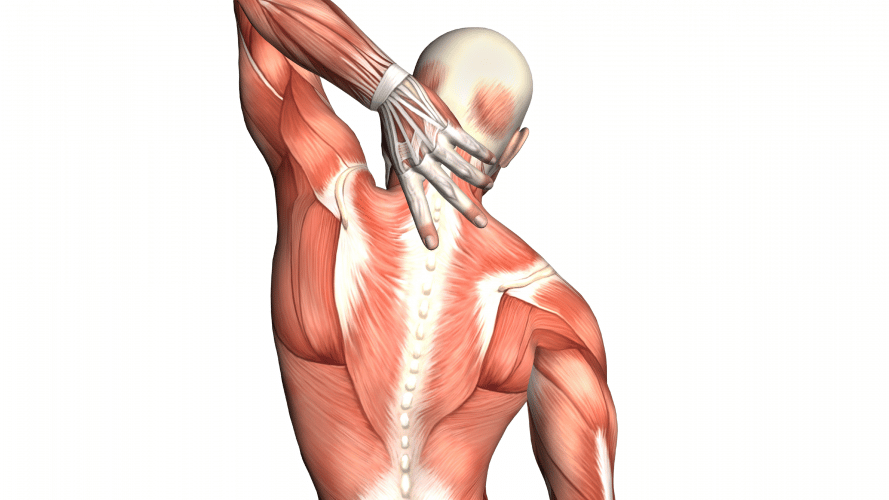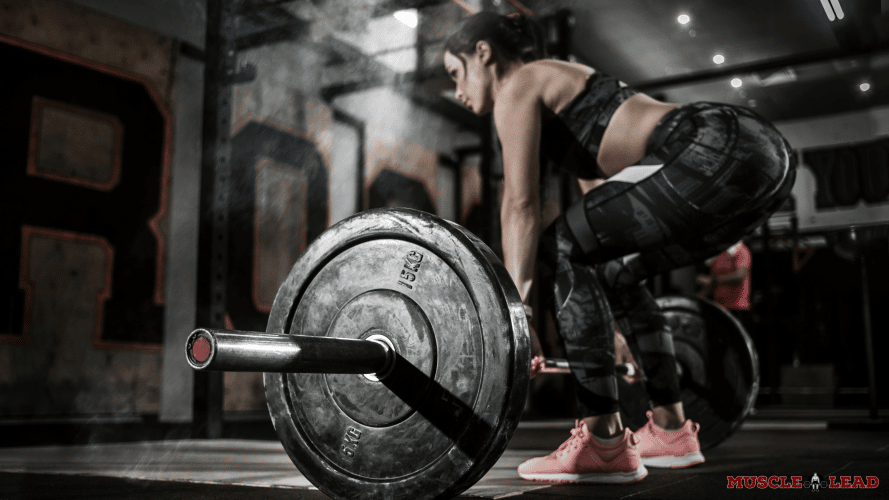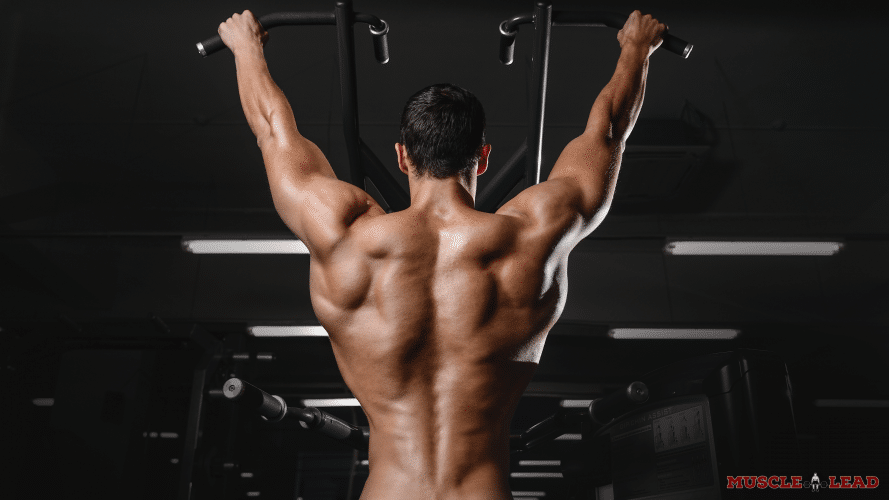Key Points
- First of all, you need to find the reason behind upper back pain while deadlifting.
- Once, you know the causes of upper back pain, you apply the solutions mentioned below and improve your deadlifts.
- Bent over barbell rows, T bar rows, rack pulls, pull ups, dumbbell pull overs and face pulls are great exercises to build your upper back.
Whether you’re a beginner or a veteran to the gym, having upper back pain while deadlifting is not uncommon.
When you lift a heavy weight, your muscles are challenged in new ways, which can lead to them feeling sore after your workout.
DOMS (delayed onset of muscle soreness) is widely accepted as ‘just one of those things’ that you have to deal with after a hard workout.
However, if you’re experiencing sharp pains after heavy deadlifts, or if you feel pain during your sets, there could be an underlying issue.
So do you have upper back pain while deadlifting? You could be lifting too much weight or rounding your upper back. Lifters may also have weak accessory muscles and not engage the core properly leading to upper back pain. Working on activation of lats, mobility, and deadlift accessory exercises will greatly help upper back pain while deadlifting.
Let’s get into the anatomy of the upper back and then discuss the reasons for your pain.
The Anatomy of the Upper Back
There are several reasons why you might get pain while deadlifting, some of which I have discussed below. First, let’s go through the anatomy of the upper back.
The upper back consists of a number of vertebrae and muscles.
The Thoracic Spine
The thoracic spine sits just below the cervical spine under the neck, and is composed of 12 thoracic vertebrae that attach to the ribs.
This part of the spine is the most stable and stiff part due to the limited range of motion around the vertebrae here.
The Upper Back Muscles
The muscles of the back are divided functionally into three groups.
- Superficial
Located towards the surface of the body, superficial muscles control movement of the upper limbs by attaching to the scapula.
Superficial muscles in the upper back are the trapezius, latissimus dorsi, the levator scapulae, and the rhomboid major and minor.
- Intermediate
Between the superficial and deep layers, the intermediate muscles can be found. These muscles include respiratory accessory muscles such as the serratus posterior superior and the serratus posterior inferior.
- Deep
The deep muscles (also referred to as intrinsic muscles) of the upper back sit underneath the intermediate layer.
They aid movement of the head and neck, and help to keep the spine stable and upright. There are several muscles that support the head and thoracic spine, including the multifidus, rotators, and semispinalis.

Role of Each Muscle
- The latissimus dorsi functions in extension, adductions, horizontal extension (transverse extension), flexion, and rotation of the shoulder joint. In other words, it does a lot! This is why activation of the lats is so important for most back exercises
- The rhomboids aid in adduction of the arms, rotation of the shoulder joint, and scapula elevation
- The trapezius muscles function in scapula adduction, elevation, depression, and outward rotation
Role of the Upper Back During Deadlifts
The upper back, in particular the lats, traps, and spinal erectors, are required in order to perform a deadlift correctly. If any of these muscles are weak, your upper back might start to round.
This can misalignment of your spine and may put your shoulder joint at risk of injury.
Your upper back plays an important role during deadlifts. The traps help to stabilize your neck and thoracic spine.
Your lats pull the shoulders back and enable upper limb movement.
If your upper back is weak, it will cause the shoulders to round forwards and your lower back to round over.
There are also smaller muscles such as the rotators that support the shoulders as they move or rotate with the sockets. Although they are smaller than the lats, rhomboids, and trapezius muscles, they are just as important when it comes to your deadlifting form.
When you initially pull the bar off the floor, the lats are required to hold it firmly in place.
They hold the spine in extension while the bar travels up over the shins. From here, you’re into the middle part of the deadlift.
During this part of the rep, the upper body muscles need to maintain extension of the spine throughout. Towards the top of the rep, the lats are required to pull the shoulder blades back to properly lockout.
Why does Your Upper Back Hurt During Deadlifts?
Most people experience upper back pain during deadlifts because their form is off.
I have seen many clients making one or more of the common mistakes that have led to a breakdown in their form. Luckily, I was able to intervene before they injured themselves.
But if you don’t have a personal trainer or friend to keep an eye on you while deadlifting, make note of the following common mistakes that are made with this exercise.
1. Your Upper Back is Rounded
When your upper back muscles are weak, or if you’re not activating them properly during deadlifts, your thoracic spine can start to round.
This is enhanced in those who already have poor posture. ‘Forward shoulder’ occurs when the shoulders round over and the head sticks out anteriorly. This can lead to acute and chronic pain in the neck and upper back, and deadlifting with rounded shoulders will only strengthen this issue, causing you more pain.
Be sure to check your form in the mirror, or get your coach or a friend to check for you. Make sure you are activating your lats and pulling your shoulders back during deadlifts to prevent upper back pain while deadlifting.
2. You’re Lifting Too Heavy
Many people go straight into to the free weights section, grab a barbell, and shove a bunch of weight on there without a second thought. Even if you’ve been resistance training for years, you still need to take precautions when it comes to the weight you’re lifting.
If you find you’re getting pain in your upper back whilst deadlifting, it could be because you’re lifting a weight that is too heavy.
Deadlifts target the whole body. As the upper back muscles are much smaller, they won’t be able to handle as much weight as your lower body muscles. Keep this fact in mind when loading the barbell before your deadlift workout.
3. Weak Accessory Muscles
The deadlift is such a total body movement that any weak accessory muscles can lead to upper back pain while deadlifting.
For instance, weak trap muscles can lead to your upper back taking more of the load and causing pain.
In fact, world-class deadlifter Cailer Woolam would work on heavy shrugs to strengthen his deadlift ability.
Heavy shrugs work on those traps so you can look yolked.
4. Not Engaging Your Core
If you fail to engage your core, it could lead to your upper back rounding forwards or your head dropping. This can cause pain in the shoulders as some of the force moves through the joints.
It can also greatly increase your risk of injury.
Before lifting the bar off the ground, make sure you take a deep breath and brace your core. Your spine should stay in extension throughout the whole set.
How Should You Breathe During Deadlifts: The Proper Way
Some people like to hold their breath temporarily for each set to keep their upper body stable. If you decide to do this, please remember to take a breath between each rep so you don’t pass out!
5. Having the Bar Too Far Away
Holding the bar too far away from your body makes it difficult to stabilize yourself. When you have to reach to grab the bar in front of you, your upper back is naturally going to round over.
Then when you start the movement, you’re pulling the bar from an unstable, rounded position. This completely throws your form off for the rest of the movement, increasing your chances of feeling pain or getting injured.
How to Fix Upper Back Pain During Deadlifts
1. Lower the Weight
When you use a weight that is too heavy for your muscles to handle, your form will breakdown. This leads to the shoulders rounding forwards and the neck dropping, both of which can lead to upper back pain.
Therefore, if you experience issues in your upper body whilst deadlifting, the first thing you should do is lower the weight.
2. Muscle Activation
For those of you who struggle to maintain proper form when deadlifting, try activating the muscles beforehand. This can be done either using body weight, resistance bands, or an unloaded barbell.
Do some arm circles to mobilize the shoulder joint.
Or grab a band and do some overhead extensions and rear delt pulls to wake up the muscles. Finally, grab the barbell with no additional weight and perform 1-2 sets of deadlifts as part of your muscle activation and warm up routine.
Activation for deadlifts is particular important in your lats.
They are the largest muscle in your back, and they take the lead for the upper body when you are deadlifting. They help transfer the force between the upper and lower body.
Without properly activated and engaged lats, your upper or lower back can start to round. Therefore, engaging the lats before you lift is key to maintaining good form and reducing the risk of upper body pain.
3. Keep Your Spine and Neck Neutral
Any excessive arching of the spine should be avoided at all times, especially when you’re deadlifting.
Consistently rounding your back compresses the vertebrae and can lead to pain in the muscles and joints further down the line.

To keep your neck and spine neutral, make sure you activate your lats and embrace your core. This will keep your upper body in a straight line, preventing injury and pain.
4. Avoid Overextension
Something that many people do at the top of the lift is overextend their spine. They push their hips forwards as though they are doing a hip thrust.
Not only does this put the spine in a vulnerable position, but it reinforces bad form.
When you reach the top of the rep, you should squeeze your glutes. This will naturally push your hips slightly forwards, but not to the point where the lower back is arched.
5. Strengthen Your Back Muscles
A huge reason of upper back pain during deadlifts is having weak upper body muscles. I have gone through the role of the upper back muscles in this compound exercise, and I have highlighted just how important they are if you want to have good deadlifting technique.
Work on strengthening these muscles so that they can support the lower body when you’re lifting a heavy barbell.

6. Try Farmer Walks
Farmer walks are not an exercise I’ve seen many people doing in the gym, but they are actually an amazing way to strengthen your upper back. During farmer walks, you hold a heavy weight by your chest in a hugging position. This activates the core and the upper back muscles.
Because you are hugging the weight, your upper back and mid back (your traps and rhomboids) are placed under tension and they work to hold the scapulas back and down and maintain your posture.
The lats are activated to help you hold the weight up. This upper body tension and activation is exactly what happens during deadlifts in order to support the weight.
7. Do Some Rack Pulls
Rack pulls are a great way to enhance your deadlift. They involve placing the loaded barbell on a squat rack with the pins being somewhere around knee height.
From here, you pull the bar up to lockout, before lowering it back down under control. It’s basically like doing the top portion of a deadlift.
The key with rack pulls is to place the bar at knee height or just below. This ensures you get a decent range of motion.
Rack Pulls vs Deadlifts: Key Differences and Benefits
They are a great way to strengthen the upper back muscles, which will translate to a better deadlift, and may reduce upper body pain. I love rack pulls because they emphasize the upper body by reducing lower body recruitment, making them an amazing way to focus on your upper back.
Rack pulls can be used as an accessory to your deadlifts, or as a temporary replacement to them.
If you decide to do the latter, slowly move the pins closer to the floor over time, until you can eventually move on to deadlifting from the floor.
8. Practice Upper Body Mobility
When your thoracic spine does not move properly, it’s going to be difficult to properly perform a deadlift. For this reason, mobilizing your thoracic spine is great to improve your deadlift form and remove any upper back pain.
Exercises include thoracic extensions, side-lying rotations, and neck circles. I’d recommend practicing your mobility at least three times a week to begin with, especially just before a deadlift workout.
9. Practice Concentric Holds
Performing concentric holds strengthens the mind-muscle connection. Try holding rows or vertical pulls will help your posture and reinforces the scapula positioning that is required for deadlifts.
Start with a lightweight that you can easier hold for 15-20 seconds, and slowly work up from there.
Hold the position with your chest lifted, and your shoulders back and down. Concentric holds are great to use as part of a priming session before deadlifting, or as part of an active recovery session.
Frequently Asked Questions
Some great back exercises include bent over barbell rows, T bar rows, rack pulls, pull ups, dumbbell pull overs and face pulls. Whether your goal is to gain width in your lats or to increase upper body strength, pretty much all back exercises will contribute to a better deadlift.
For power gains, work within a rep range of 1-3. Focus on lifting as heavy as possible and take rest periods of 3-5 minutes between each set. If your goal is to gain strength, you can work within 3-6 reps. Again, focus on pushing a heavy weight and your rest periods should be between 1.5-2 minutes. Finally, if you’re working on improving your endurance, try reps of 12-15, and your rest periods can be around 30 seconds to a minute.
As part of a warm up routine, you can try foam rolling or using a cardio machine that requires upper body recruitment such as rowing. From here, if you have a band, try doing some arm circles and band pull-aparts. Finally, you can grab an unloaded barbell and do a couple of sets of light deadlifts to get your body moving.
Final Thoughts
When it comes to upper back pain while deadlifting, your whole body is important. The upper body plays a key role in maintaining proper form and keeping you safe. If you’re experiencing upper back pain during deadlifts, it’s important to identify the cause of the issue, as it can be due to a number of different things.
Whether this is through mobility work, strengthening the upper back muscles, or practicing accessory movements, there are lots of things you can do to remove or reduce any upper back pain you might be feeling during deadlifts.





